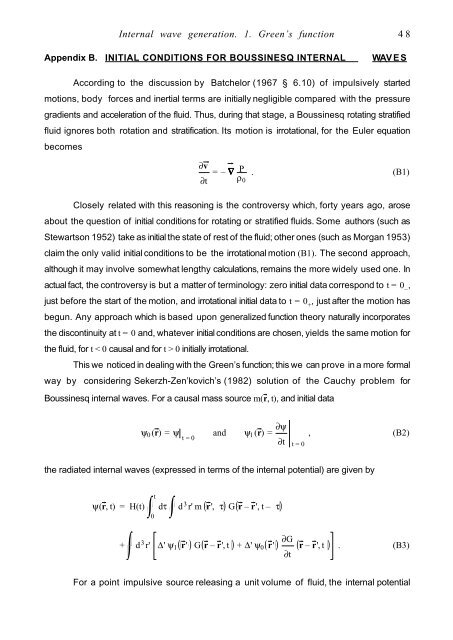Internal Wave Generation in Uniformly Stratified Fluids. 1 ... - LEGI
Internal Wave Generation in Uniformly Stratified Fluids. 1 ... - LEGI
Internal Wave Generation in Uniformly Stratified Fluids. 1 ... - LEGI
Create successful ePaper yourself
Turn your PDF publications into a flip-book with our unique Google optimized e-Paper software.
Appendix B. INITIAL CONDITIONS FOR BOUSSINESQ INTERNAL WAVES<br />
Accord<strong>in</strong>g to the discussion by Batchelor (1967 § 6.10) of impulsively started<br />
motions, body forces and <strong>in</strong>ertial terms are <strong>in</strong>itially negligible compared with the pressure<br />
gradients and acceleration of the fluid. Thus, dur<strong>in</strong>g that stage, a Bouss<strong>in</strong>esq rotat<strong>in</strong>g stratified<br />
fluid ignores both rotation and stratification. Its motion is irrotational, for the Euler equation<br />
becomes<br />
<strong>Internal</strong> wave generation. 1. Green’s function 48<br />
∂v<br />
∂t<br />
= – ∇ P<br />
ρ0<br />
. (B1)<br />
Closely related with this reason<strong>in</strong>g is the controversy which, forty years ago, arose<br />
about the question of <strong>in</strong>itial conditions for rotat<strong>in</strong>g or stratified fluids. Some authors (such as<br />
Stewartson 1952) take as <strong>in</strong>itial the state of rest of the fluid; other ones (such as Morgan 1953)<br />
claim the only valid <strong>in</strong>itial conditions to be the irrotational motion (B1). The second approach,<br />
although it may <strong>in</strong>volve somewhat lengthy calculations, rema<strong>in</strong>s the more widely used one. In<br />
actual fact, the controversy is but a matter of term<strong>in</strong>ology: zero <strong>in</strong>itial data correspond to t = 0 – ,<br />
just before the start of the motion, and irrotational <strong>in</strong>itial data to t = 0 + , just after the motion has<br />
begun. Any approach which is based upon generalized function theory naturally <strong>in</strong>corporates<br />
the discont<strong>in</strong>uity at t = 0 and, whatever <strong>in</strong>itial conditions are chosen, yields the same motion for<br />
the fluid, for t < 0 causal and for t > 0 <strong>in</strong>itially irrotational.<br />
This we noticed <strong>in</strong> deal<strong>in</strong>g with the Green’s function; this we can prove <strong>in</strong> a more formal<br />
way by consider<strong>in</strong>g Sekerzh-Zen’kovich’s (1982) solution of the Cauchy problem for<br />
Bouss<strong>in</strong>esq <strong>in</strong>ternal waves. For a causal mass source m(r, t), and <strong>in</strong>itial data<br />
ψ0 (r) = ψ t = 0 and ψ1 (r) = ∂ψ<br />
∂t<br />
t = 0<br />
, (B2)<br />
the radiated <strong>in</strong>ternal waves (expressed <strong>in</strong> terms of the <strong>in</strong>ternal potential) are given by<br />
t<br />
ψ(r, t) = H(t) dτ<br />
0<br />
d 3 r' m r', τ G r – r', t – τ<br />
+ d 3 r' Δ' ψ1 r' G r – r', t + Δ' ψ0 r' ∂G<br />
∂t<br />
r – r', t . (B3)<br />
For a po<strong>in</strong>t impulsive source releas<strong>in</strong>g a unit volume of fluid, the <strong>in</strong>ternal potential


